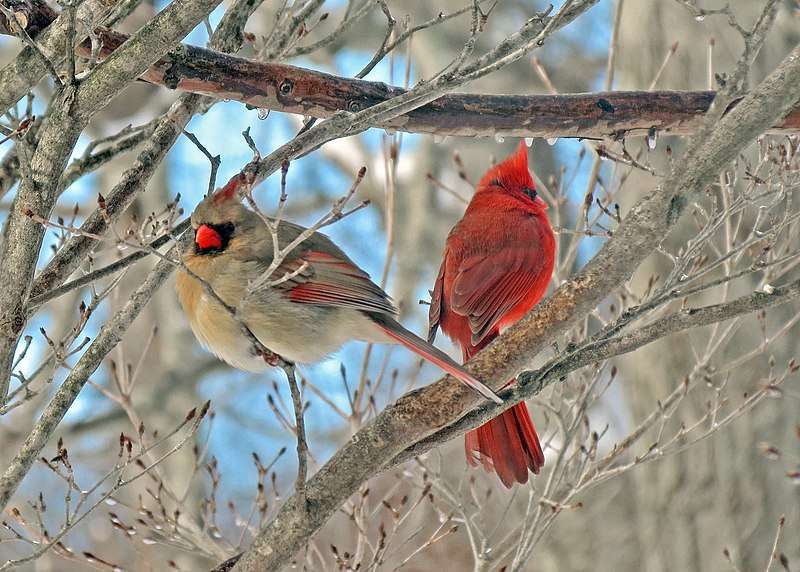SCORES & OUTDOORS: The northern cardinal: bird of the season

 by Roland D. Hallee
by Roland D. Hallee
One of my wife’s favorite birds is the northern cardinal. We’ve had a nesting pair hanging around our house for a couple of years now, and we both enjoy watching the brilliant red male go about its business. The northern cardinal is also synonymous with winter, and adorns many a Christmas card.
That has not always been the case.
One of our most popular birds, the cardinal is the official state bird of no fewer than seven eastern states: Illinois, Indiana, Kentucky, North Carolina, Ohio, Virginia and West Virginia. Abundant in the Southeast, it has been extending its range northward for decades, and it now brightens winter days with its color and its whistled song as far north as southeastern Canada. Feeders stocked with sunflower seeds may have aided its northward spread. West of the Great Plains, the Cardinal is mostly absent, but it is locally common in the desert Southwest.
Widespread and abundant, having expanded its range over the last century or more, the current numbers are probably stable. It inhabits woodland edges, thickets, suburban gardens, towns, desert washes. Found in a wide variety of brushy or semi-open habitats in the East, from forest clearings and swamps to city parks, almost wherever there are some dense bushes for nesting. It forages mostly while hopping on the ground or in low bushes, sometimes higher in trees. They readily come to bird feeders, where it favors sunflower seeds.
The male Northern Cardinal is perhaps responsible for getting more people to open up a field guide than any other bird. They have a a shade of red you can’t take your eyes off. Even the brown females sport a sharp crest and warm red accents. Cardinals don’t migrate and they don’t molt into a dull plumage, so they’re still breathtaking in winter’s snowy backyards. In summer, their sweet whistles are one of the first sounds of the morning.
Both parents feed nestlings. Young leave the nest about 9 – 11 days after hatching. Males may feed fledglings while females begin the next nesting attempt. They have two to three broods per year, rarely four.
Their diet consists mostly of seeds, insects, berries. Diet is quite varied. They feed on many insects, including beetles, true bugs, grasshoppers, caterpillars, ants, flies, and many others, also spiders, centipedes, and snails. Most of their diet is vegetable matter, including seeds of weeds and grasses, waste grain, leaf buds, flowers, and many berries and wild fruits. Young are fed mostly insects.
While nesting, the male sings to defend nesting territory, actively attacking intruding males (and attacking his own reflection in windows and mirrors). In courtship, male and female raise heads high, sway back and forth while singing softly; male often feeds female early in breeding season. The female sings mainly in spring before the start of nesting. The nest is usually well hidden in dense shrubs, vines, or low trees, placed 3 – 10 feet above ground, sometimes higher. Nest (built by female) is open cup made of twigs, weeds, grass, bark strips, leaves, rootlets, lined with fine grass or hair.
Nearly any bird feeder you put out ought to attract Northern Cardinals (as long as you live within their range), but they particularly seem to use sunflower seeds. Leave undergrowth in your backyard or around the edges, and you may have cardinals nesting on your property.
Here are some cool facts about cardinals:
– Only a few female North American songbirds sing, but the female Northern Cardinal does, and often while sitting on the nest. This may give the male information about when to bring food to the nest. A mated pair shares song phrases, but the female may sing a longer and slightly more complex song than the male.
– Many people are perplexed each spring by the sight of a cardinal attacking its reflection in a window, car mirror, or shiny bumper. Both males and females do this, and most often in spring and early summer when they are obsessed with defending their territory against any intruders. Birds may spend hours fighting these intruders without giving up. A few weeks later, as levels of aggressive hormones subside, these attacks should end.
– The male cardinal fiercely defends its breeding territory from other males. When a male sees its reflection in glass surfaces, it frequently will spend hours fighting the imaginary intruder.
– The oldest recorded Northern Cardinal was a female, and was 15 years, 9 months old when she was found in Pennsylvania.
Mighty House Mouse Update
Well, he’s baaaack!
Another trap destroyed. I checked on my traps, and sure enough, another broken trap. One of my brand new ones. Sooner or later, I’m going to get down to the bottom of this.
Roland’s trivia question of the week:
Who was the last Boston Bruins player to score 100 points or more before David Pastrnak’s 113 in 2022-23?
Responsible journalism is hard work!
It is also expensive!
If you enjoy reading The Town Line and the good news we bring you each week, would you consider a donation to help us continue the work we’re doing?
The Town Line is a 501(c)(3) nonprofit private foundation, and all donations are tax deductible under the Internal Revenue Service code.
To help, please visit our online donation page or mail a check payable to The Town Line, PO Box 89, South China, ME 04358. Your contribution is appreciated!


Leave a Reply
Want to join the discussion?Feel free to contribute!